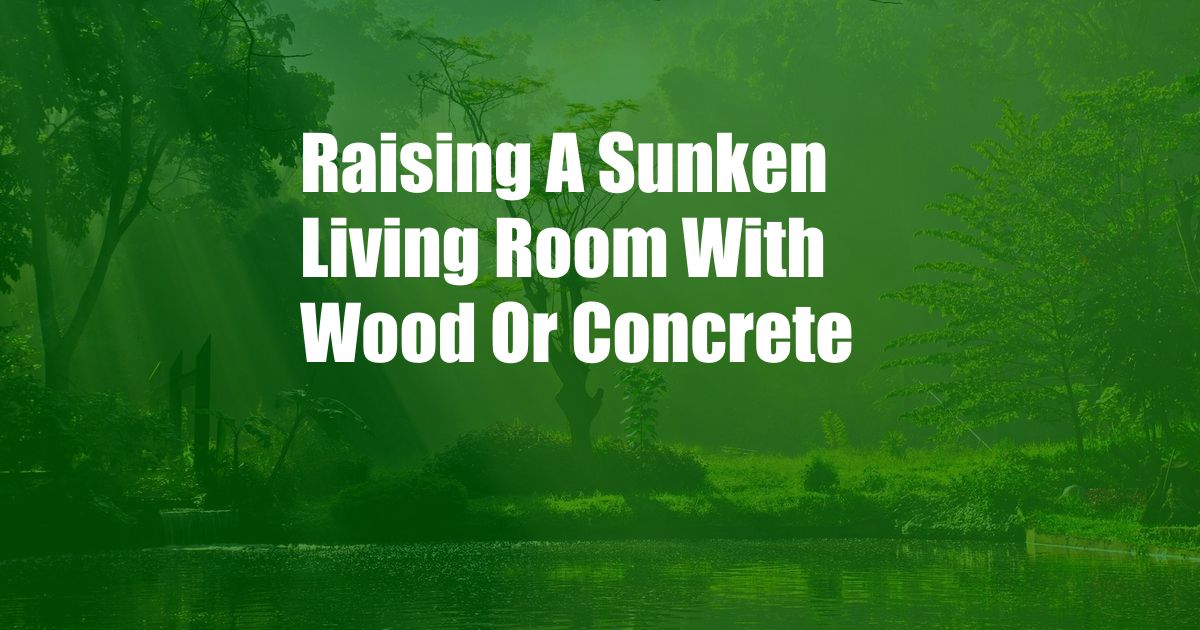
A Sunken Living Room’s Elevation: Wood or Concrete?
In our quest for a more spacious and aesthetically pleasing home, we often stumble upon the allure of sunken living rooms. These architectural gems, characterized by their lowered position compared to the rest of the house, exude an air of coziness and exclusivity. However, when the time comes to renovate or elevate these sunken living rooms, homeowners are faced with a crucial decision: should they opt for wood or concrete as the primary material?
The choice between wood and concrete for raising a sunken living room warrants careful consideration, as each material possesses distinct advantages and drawbacks. In this article, we will delve into the intricacies of both materials, exploring their properties, benefits, and limitations, to help you make an informed decision that best suits your needs and preferences.
Wood: A Natural Choice
Wood has long been a favored material for construction due to its versatility, warmth, and aesthetic appeal. When it comes to elevating a sunken living room, wood offers several advantages. Firstly, it is a lightweight material, making it easier to transport and install compared to concrete. This can be a significant advantage, especially when working in confined spaces or on upper floors.
Wood is also known for its insulating properties, which can help regulate temperature within the sunken living room. During winter months, the wood’s natural insulation can help keep the room warm and cozy, reducing energy consumption for heating. Additionally, the natural grain patterns and textures of wood add a touch of warmth and character to the space.
Concrete: A Solid Foundation
Concrete, on the other hand, is a resilient and durable material that provides a solid and stable base for elevating a sunken living room. Unlike wood, concrete is not susceptible to rot or insect infestations, making it a more durable option in the long run. It is also fire-resistant, enhancing the overall safety of your home.
The strength and stability of concrete make it an excellent choice for supporting heavy loads or creating intricate structural designs. This is particularly advantageous if you plan to incorporate additional features into your sunken living room, such as built-in seating, storage units, or even a fireplace. However, concrete is a heavier material compared to wood, which can make transportation and installation more challenging.
Tips and Expert Advice
When choosing between wood and concrete for raising a sunken living room, consider these expert tips:
- Assess the existing structure: Before making a material choice, it is crucial to thoroughly inspect the existing structure of your sunken living room. This will help determine the weight-bearing capacity and the most suitable material for the elevation.
- Consider long-term durability: If durability and longevity are your primary concerns, concrete may be a better choice due to its resistance to rot, insects, and fire. However, if you prefer a more aesthetically pleasing material, wood offers a wide range of options to complement your home’s décor.
- Plan for maintenance: Both wood and concrete require regular maintenance to ensure their longevity. Wood may require periodic staining or sealing to protect it from moisture and UV damage, while concrete may need occasional sealing to prevent cracking.
- Consult a professional: If you are unsure about the best material choice for your sunken living room elevation project, it is highly recommended to consult with an experienced contractor or structural engineer. They can provide expert advice based on your specific requirements and the existing conditions of your home.
FAQ
Q: Is it possible to raise a sunken living room using both wood and concrete?
A: Yes, it is possible to combine wood and concrete for a sunken living room elevation. However, this approach requires careful planning and execution to ensure proper load distribution and structural integrity.
Q: What is the average cost of raising a sunken living room?
A: The cost of raising a sunken living room can vary significantly depending on factors such as the size of the room, the material chosen, and the complexity of the project. It is recommended to obtain quotes from multiple contractors to get an accurate estimate.
Q: Is it necessary to obtain permits for raising a sunken living room?
A: Yes, it is generally necessary to obtain building permits for any structural modifications to your home, including raising a sunken living room. Contact your local building department for specific requirements and regulations.
Conclusion
Elevating a sunken living room can significantly enhance the functionality and aesthetics of your home. When it comes to choosing the right material, both wood and concrete offer distinct advantages and drawbacks. Wood provides a lightweight, insulating, and aesthetically pleasing option, while concrete offers superior durability, strength, and fire resistance. By carefully considering your needs, preferences, and the existing structure of your home, you can make an informed decision that will best meet your requirements.
Are you considering raising a sunken living room in your own home? If so, we encourage you to explore our website for more detailed information and expert advice on this topic. By following our tips and consulting with qualified professionals, you can successfully transform your sunken living room into a beautiful and functional space that you and your family will enjoy for years to come.